OCZ Vertex 3 (240GB) Review
by Anand Lal Shimpi on May 6, 2011 1:50 AM ESTRandom Read/Write Speed
The four corners of SSD performance are as follows: random read, random write, sequential read and sequential write speed. Random accesses are generally small in size, while sequential accesses tend to be larger and thus we have the four Iometer tests we use in all of our reviews.
Our first test writes 4KB in a completely random pattern over an 8GB space of the drive to simulate the sort of random access that you'd see on an OS drive (even this is more stressful than a normal desktop user would see). I perform three concurrent IOs and run the test for 3 minutes. The results reported are in average MB/s over the entire time. We use both standard pseudo randomly generated data for each write as well as fully random data to show you both the maximum and minimum performance offered by SandForce based drives in these tests. The average performance of SF drives will likely be somewhere in between the two values for each drive you see in the graphs. For an understanding of why this matters, read our original SandForce article.
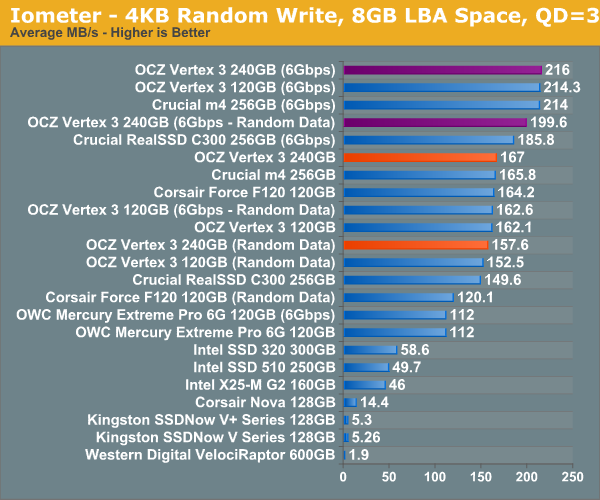
Many of you have asked for random write performance at higher queue depths. What I have below is our 4KB random write test performed at a queue depth of 32 instead of 3. While the vast majority of desktop usage models experience queue depths of 0 - 5, higher depths are possible in heavy I/O (and multi-user) workloads:
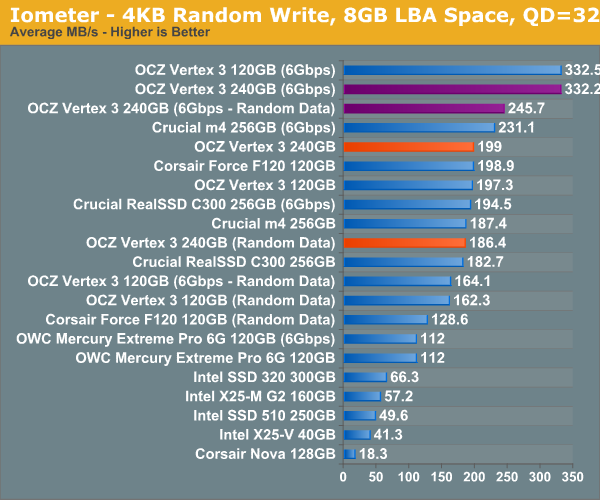
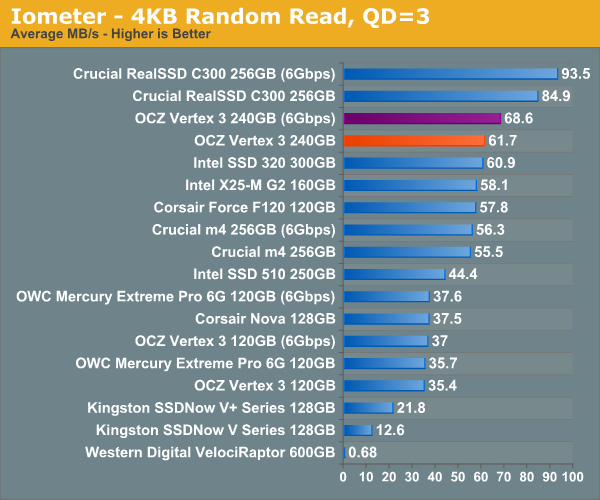
Sequential Read/Write Speed
To measure sequential performance I ran a 1 minute long 128KB sequential test over the entire span of the drive at a queue depth of 1. The results reported are in average MB/s over the entire test length.
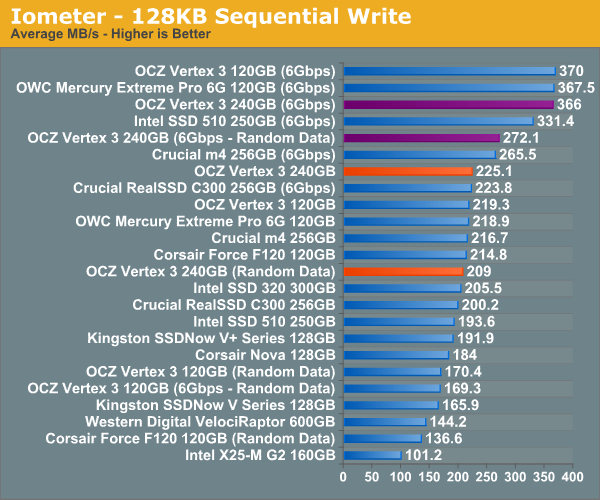
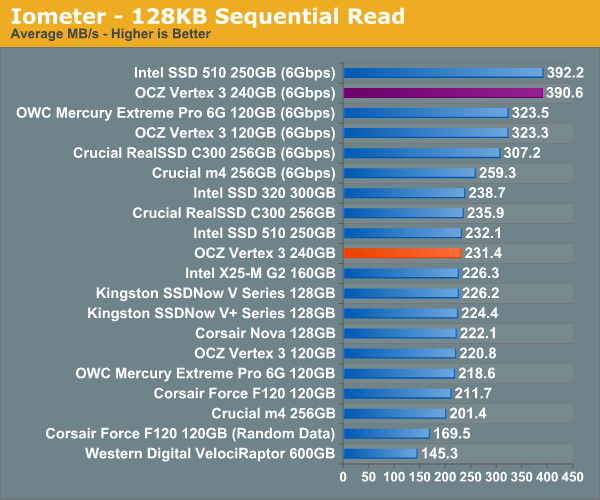










90 Comments
View All Comments
ggathagan - Friday, May 6, 2011 - link
Your takeaway is correct.I see a lot of comments in this and other SSD articles that talk about Sandforce not being ready for prime time.
As Anand has repeatedly mentioned, one of the drawbacks for a small, niche-technology company is an inability to match companies like Intel in the R&D arena.
The consumer, in essence, has been the R&D department for Sandforce.
When it comes to the average user, there are no performance examples that I can think of where a Sandforce-based drive will make enough difference to make it worth the risk over Intel.
Cutting edge technology is not worth it in this particular arena.
FunBunny2 - Friday, May 6, 2011 - link
-- When it comes to the average user, there are no performance examples that I can think of where a Sandforce-based drive will make enough difference to make it worth the risk over Intel.And, given that Enterprise data is frequently encrypted/compressed into databases, they won't be much use in Enterprise. Marvell might end up the winner as OEM controller vendor.
AlainD - Friday, May 6, 2011 - link
HiI've found that AS-SSD has a compression benchmark. Would be nice to add those to the reviews. Probably only 6GBps is usefull.
I'm surprised that the new sandforce controller is capable of sequential reading approx. 500 MB even if the data is compressed. Writing seems to be another story and then the AS-SSD compression benchmark could be some extra info.
Casper42 - Friday, May 6, 2011 - link
Bought my wife a new HP DV6T Quad Core Sandy and bought it with a traditional 640GB drive because I knew I wanted a (what I call) 3rd generation SSD which the dont offer yet.However, I noticed the Intel Storage Manager is in the System Tray and that leads me to beleive the Intel SATA driver is probably loaded too. I would think they wouldnt load this due to the previous issues with the driver breaking TRIM support under 7, but then thought perhaps they load a slightly different image on machines they ship with Factory SSDs.
Anyway, to cut to the point, Do the latest Intel SATA drivers still break Win7 TRIM support? Or has that all been fixed and I just wasn't paying attention?
Thx,
Casper
InsaneScientist - Saturday, May 7, 2011 - link
As of version 9.6 (march of last year, I think), yes the Intel drivers will work with TRIM if the drives aren't in a RAID array.Casper42 - Friday, May 6, 2011 - link
Due to the speed differences in the 120 vs 240 and the nature of SF drives and incompressible data.....I am wondering what your recommendation would be for a 120GB drive going into a Windows laptop that will be running a very traditional desktop software load. Not a lot of games, not a lot of Video Editing. Mainly just surfing the net and running Office type apps?
Budget is less of a concern than speed and reliability, but within reason. I will take a 10-20% hit on price to get a better product but approach 50% and things change.
anonapon - Friday, May 6, 2011 - link
I'm curious how this will affect SSD caching. When they come out, I'm hoping to put together a system as soon as possible with a Z68 board and I've been thinking about having a really great drive like the Vertex 3 as my system and application drive, either one 240 or two 120s in RAID0, and using a small and reliable but otherwise mediocre SSD to cache a single large mechanical drive; but, as far as I understand it, SSD caching will require the latest Intel 10.x RST drivers, and OCZ's firmware doesn't work with the latest Intel 10.x RST drivers.Is this other people's understanding as well, and does anyone know if there will be a solution soon?
mars2k - Monday, May 9, 2011 - link
I have IRST 10.xxx loaded F6 during clean Win7 SP1 x64 install on SB 2820QM, 240Gb Vertex3. Loaded Win 7 with a thumb drive. It took ten minutes or less from 1rst boot for the intall to browsing the internet. Way cool!I am experiencing some hangs. There is a fix for this on the OCZ forums. Will try.
BLU82 - Friday, May 6, 2011 - link
Great review as always Anand, but have a couple of questions for you. Do you know if you will get a sample of the 480GB V3? Not that any of us could afford one, but since these are parallel devices I would be interested to see how its performance would stack up against the 120 and 240. I am assuming that they just use the "J" designated chips over the "C"???Also, do you know what differences the newer "Max IOPS' versions would perform over these first releases? I returned a vanilla 120GB version right after I saw where OCZ introduced the MAX IOPS version but still not sure whether to go that route, try and RAID 0 two 120GB vanilla versions, MAX IOPS version, or get one 240GB vanilla or MAX IOPS version??? I liked the 120GB version and really find it hard to try and run my Sandy Bridge on a Velociraptor again, but since it was a first release and what you pointed out between the 120 and 240 versions made me think I should have just waited on a 240. But man, that price tag. Which, brings me back to the 480GB version. Don't hear anyone talking about it (due to the price I'm sure), but I would be very curious about the performance and if there are any differences between it and the 240.
Thanks again Anand. I've actually been reviewing your site since it's inception way back in the mid-late 90's. You do a great job and always have.
neotiger - Saturday, May 7, 2011 - link
In your random read benchmark, Vertex 3 120GB clocked in at 35MB/s while Corsair Force 120GB achieved a much better performance at 58MB/s.Corsair Force actually use the last generation of SandForce. So why is the new generation of SandForce so much slower than the last generation product?
Was there an error in the benchmark?